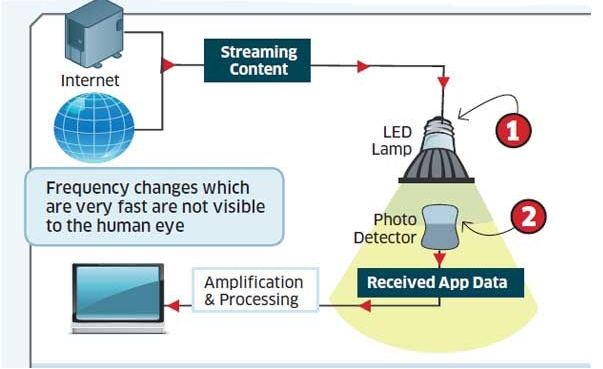
With the advances in technology, every day a new idea is being nurtured in some one’s mind that might change the way we function. One such ground breaking idea popped in the mind of a brilliant Professor in University of Edinburg, UK, Harald Haas back in 2003. His idea was to use Light Emitting Diodes as a medium to transfer data from one system to another. This topic became widely popular after his TED Talk in 2011.
Now, the question of the hour is what exactly is LI FI?
LI-FI is a short hand representation for Light Fidelity. Fidelity as per a dictionary is being faithful. As per its name, it can be safely said that this technology functions on light.
In simple terms, it is a possible alternate to Wi-Fi. While Wi-Fi uses radio signals wirelessly, LI-FI is the concept of using visible Light Spectrum.
The LED Lights have a networking component that allow multiple users to get connected to a single light source and give the ability to move from one light source to another without losing the connection.
The long term aim of the innovator is to get this technology inside various devices and lighting grids. In order to make this technology widely adaptable, it is necessary to compress the dongle into an ASIC (Application Specific Integrated Circuit) or SoC (System on a Chip), to make it easily incorporated into various devices like smartphones, laptops, tablets, accessories and many more.
Advantages of Adopting LI-FI
- As light doesn’t penetrate through walls, this technology allows the users to create secure networks with much higher security.
- The strength of the network can be enhanced with increasing the number of light sources. This can lead to a much efficient network.
- Once these sensors and dongles become more adoptable, we can use a low cost, low power consuming and environment friendly technology in our day-to day lives.
- LI-FI has the calibre to boost its capacity to transfer the data at a rate that can be roughly 100 times of Wi-Fi technology by the usage of laser LEDs.
- The LI-FI network allows the users the roam around the room or anywhere in the installed lightning grid.
- LI-FI adoption can reduce the strain from the existing networks and free the bandwidth for outdoors.
Article Source: http://EzineArticles.com/expert/Jayasree_Challa/2298402

Permalink
Permalink
Permalink
Permalink
Permalink
Permalink
Permalink
Permalink